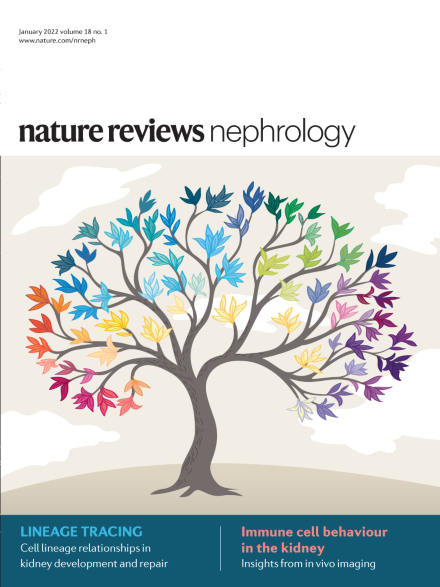Neutrophils and NETs in kidney disease
IF 39.8
1区 医学
Q1 UROLOGY & NEPHROLOGY
引用次数: 0
Abstract
Neutrophils, conventionally regarded as a homogeneous immune cell population, have emerged as a heterogeneous group of cells with distinct gene profiles and immune properties. Activated neutrophils release a spectrum of bioactive substances, including cytokines, chemokines, proteolytic enzymes, reactive oxygen species and neutrophil extracellular traps (NETs), which are composed of decondensed DNA and antimicrobial proteins. NETs have a pivotal role in innate immunity, including in preventing the ascent of uropathogenic bacteria into the kidneys, as they efficiently trap pathogenic microorganisms. However, although indispensable for defence against pathogens, NETs also pose risks of self-damage owing to their cytotoxicity, thrombogenicity and autoantigenicity. Accordingly, neutrophils and NETs have been implicated in the pathogenesis of various disorders that affect the kidneys, including acute kidney injury, vasculitis, systemic lupus erythematosus, thrombotic microangiopathy and in various aetiologies of chronic kidney disease. Pathological alterations in the glomerular vascular wall can promote the infiltration of neutrophils, which can cause tissue damage and inflammation through their interactions with kidney-resident cells, including mesangial cells and podocytes, leading to local cell death. Targeting neutrophil activation and NET formation might therefore represent a new therapeutic strategy for these conditions. Neutrophils and neutrophil extracellular traps are known for their key role in pathogen clearance. Here, the authors explore the dual role of neutrophils and neutrophil extracellular traps, as they can also have a pathogenic role in many kidney diseases through pro-inflammatory and pro-thrombotic effects, and by promoting autoimmunity.


肾脏疾病中的中性粒细胞和NETs
中性粒细胞,传统上被认为是一个同质的免疫细胞群,已经成为具有不同基因谱和免疫特性的异质细胞群。活化的中性粒细胞释放一系列生物活性物质,包括细胞因子、趋化因子、蛋白水解酶、活性氧和中性粒细胞胞外陷阱(NETs),它们由去致密的DNA和抗菌蛋白组成。net在先天免疫中具有关键作用,包括防止尿路致病菌进入肾脏,因为它们能有效地捕获致病微生物。然而,尽管net对于防御病原体是必不可少的,但由于其细胞毒性、血栓形成性和自身抗原性,也会造成自我损伤的风险。因此,中性粒细胞和NETs与各种影响肾脏的疾病的发病机制有关,包括急性肾损伤、血管炎、系统性红斑狼疮、血栓性微血管病和各种慢性肾脏疾病的病因。肾小球血管壁的病理改变可促进中性粒细胞的浸润,中性粒细胞可通过与肾系膜细胞和足细胞等肾驻留细胞的相互作用引起组织损伤和炎症,导致局部细胞死亡。因此,靶向中性粒细胞活化和NET形成可能代表了一种新的治疗策略。
本文章由计算机程序翻译,如有差异,请以英文原文为准。
求助全文
约1分钟内获得全文
求助全文
来源期刊

Nature Reviews Nephrology
医学-泌尿学与肾脏学
CiteScore
39.00
自引率
1.20%
发文量
127
审稿时长
6-12 weeks
期刊介绍:
Nature Reviews Nephrology aims to be the premier source of reviews and commentaries for the scientific communities it serves.
It strives to publish authoritative, accessible articles.
Articles are enhanced with clearly understandable figures, tables, and other display items.
Nature Reviews Nephrology publishes Research Highlights, News & Views, Comments, Reviews, Perspectives, and Consensus Statements.
The content is relevant to nephrologists and basic science researchers.
The broad scope of the journal ensures that the work reaches the widest possible audience.
 求助内容:
求助内容: 应助结果提醒方式:
应助结果提醒方式:


